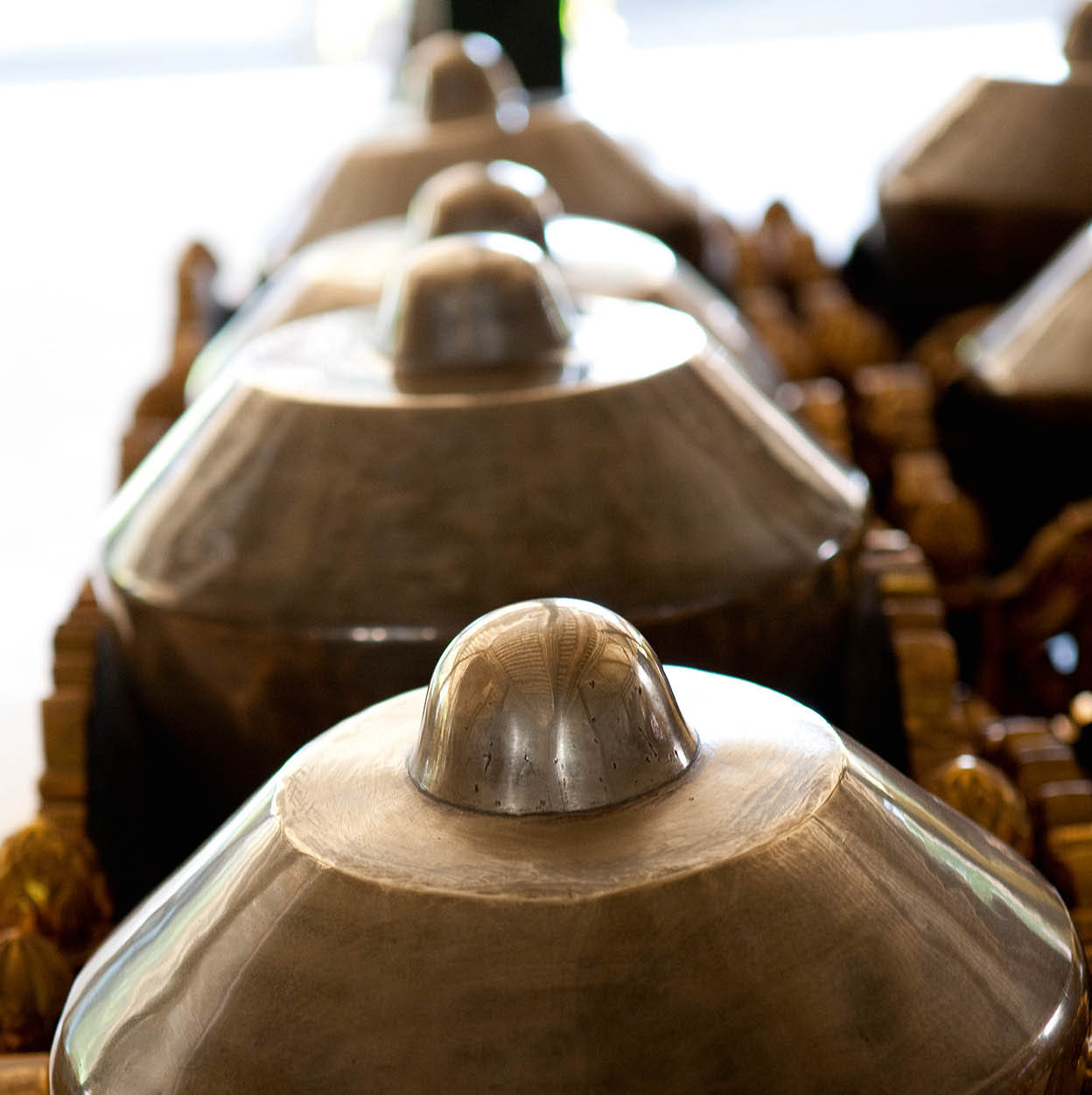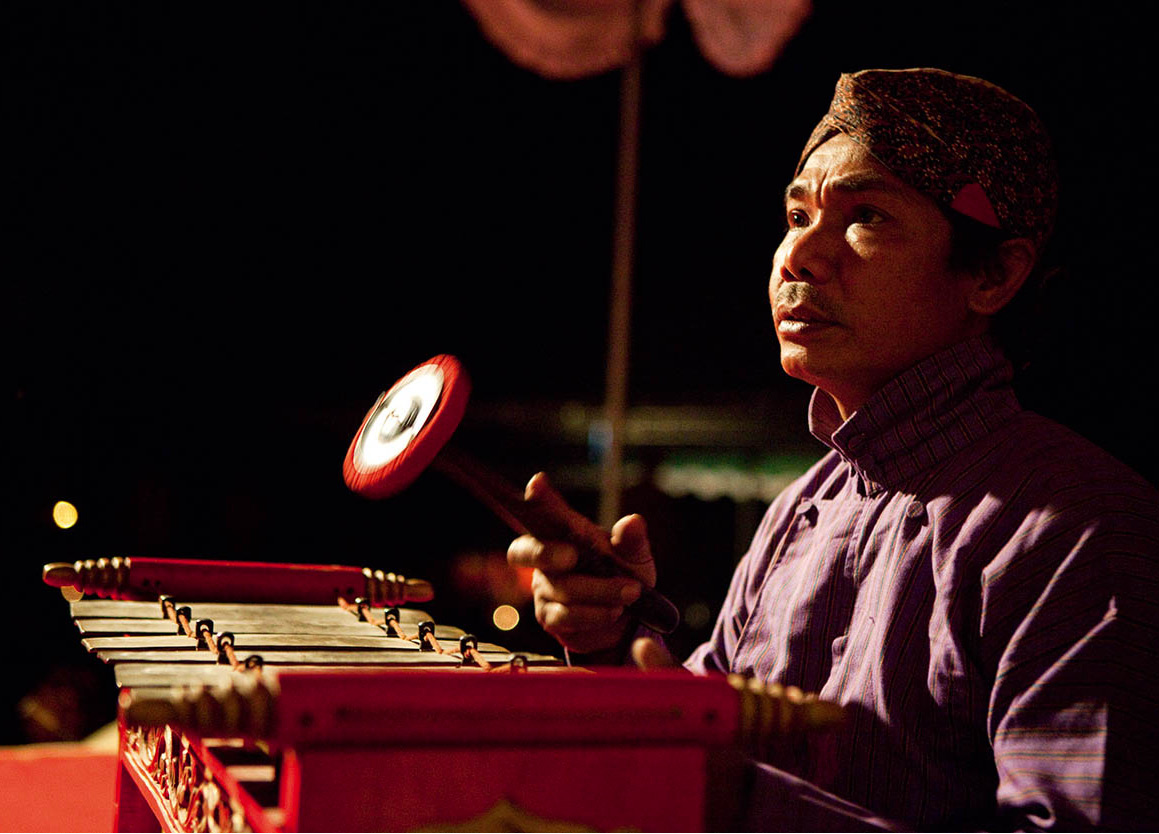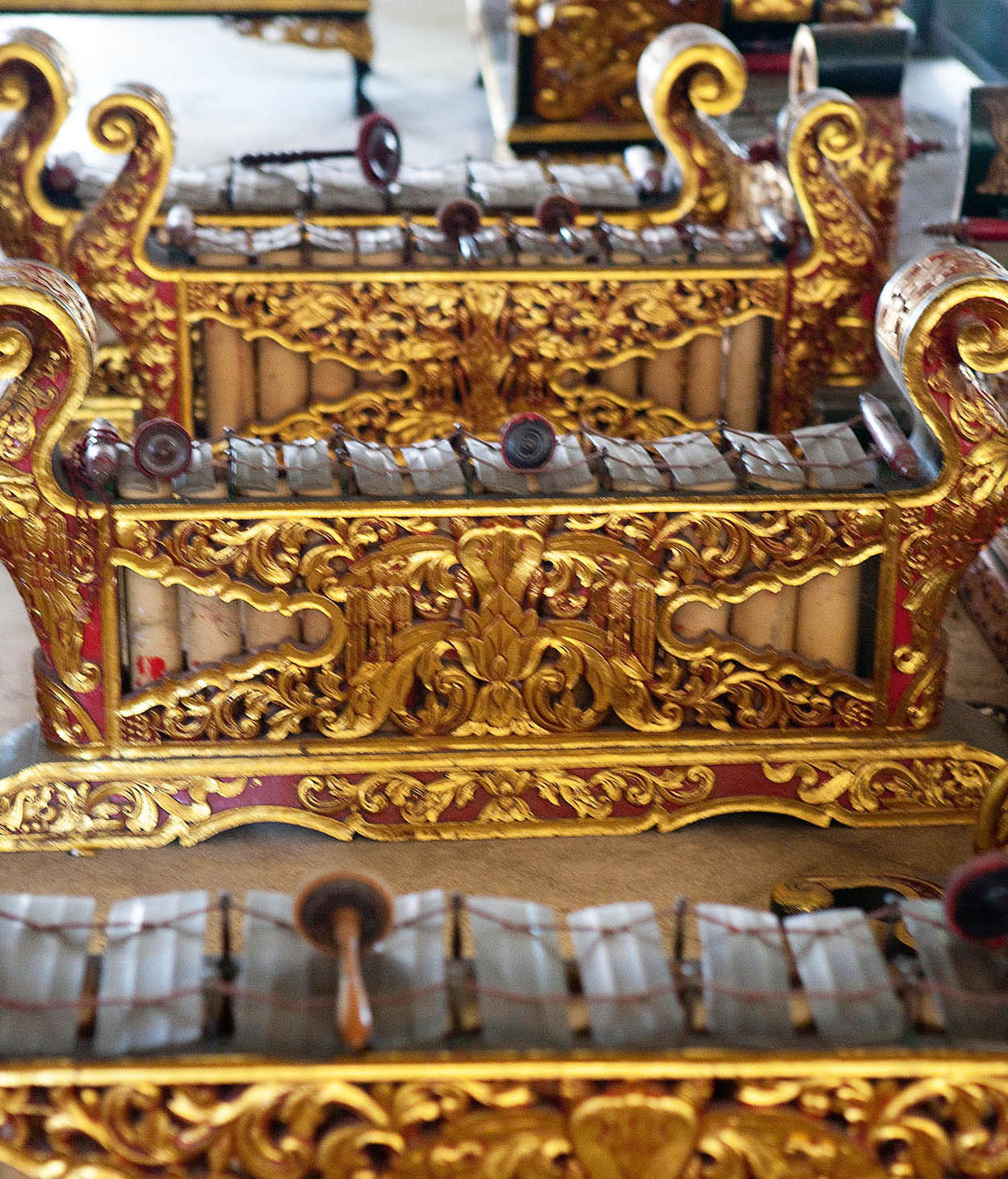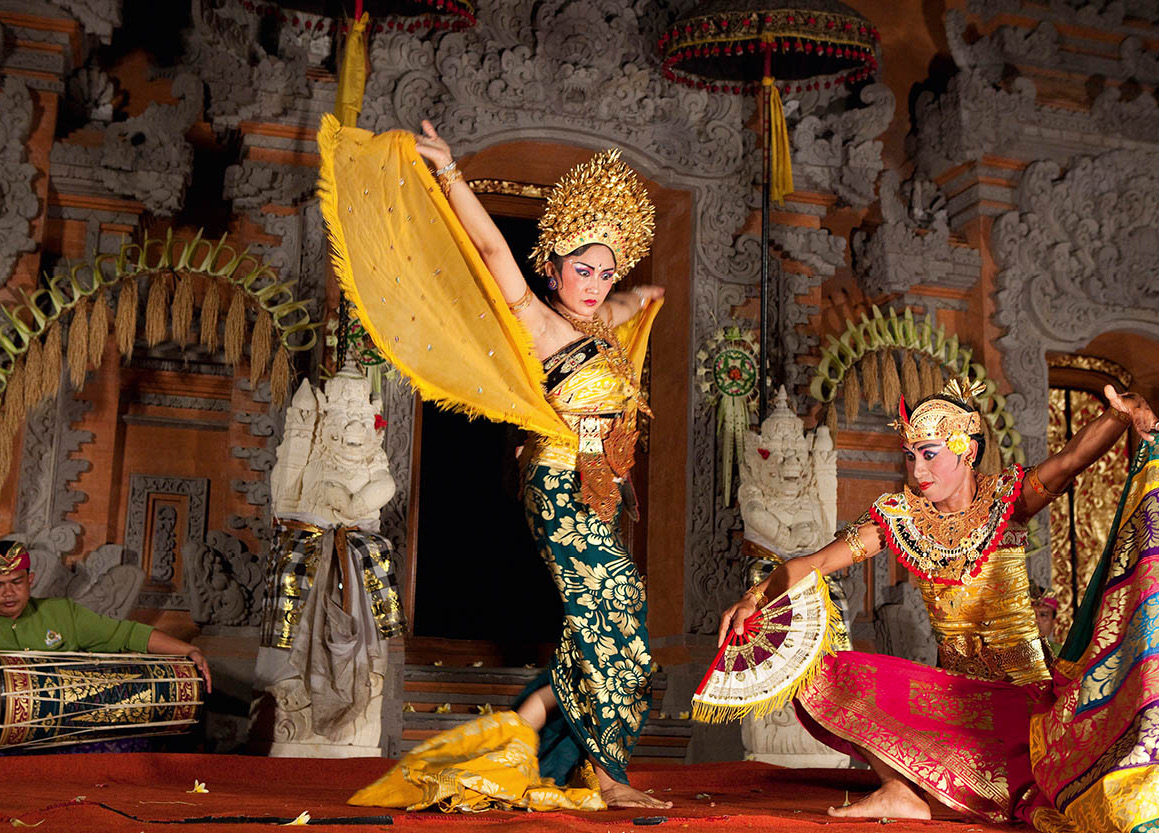Gamelan music is comparable to two things: moonlight and flowing water. It is pure and mysterious like the first and ever-changing like the second. Since 1893, when Claude Debussy first heard a Javanese ensemble perform at the Paris International Exhibition, the haunting and hypnotic tones of the gamelan have fascinated the West. This music has been studied by scholars – the earliest were Jaap Kunst and Colin McPhee – and is now recognised as one of the world’s most sophisticated musical arts.
The term gamelan derives from gamel, an old Javanese word for handle or hammer, as most of the instruments in the orchestra are percussive. The interlocking rhythmic and melodic patterns found in gamelan music are said to originate in the rhythms of the lesung – the wooden mortars used for husking rice. Others ascribe the patterns to the chanting of frogs in the rice fields after dusk.
No one knows exactly when the first gamelan came into being. The manufacture of bronze gongs and drums is associated with the Dong Son bronze culture that is thought to have reached Indonesia from Indochina in the 3rd century BC. Since then, large bronze gongs have formed the heartbeat of this distinctive music, with a deep and penetrating sound that can be heard for miles on a quiet night.

Gamelan instruments.
Corrie Wingate/Apa Publications
Javanese gamelan
Gamelan ensembles are most commonly performed to accompany dance and theatre. Karawitan is the Indonesian term coined in the 1950s by Ki Sindusawarno, the first director of the music conservatory in Surakarta, for the entire range of Javanese and Balinese performing arts incorporating gamelan music.
In Java, karawitan and related arts reached the height of refinement in the Islamic courts of the 18th and 19th centuries resulting in slow, stately and mystical music, designed to be heard in the large audience hall of the aristocratic home and to convey a sense of awesome power and emotional control.
Between five and 40 instruments make up a gamelan ensemble, and most of them are never played alone. Two instruments, the rebab (a two-stringed bowed lute, probably of Middle Eastern origin) and the suling (bamboo flute), are non-percussive and were probably later additions to the ensemble.
A basic principle underlying all gamelan music is that of stratification, in which the density of notes played on each instrument is determined by its register; higher instruments play more notes than lower ones.
The Fahnestock and Smithsonian recordings
The Fahnestock brothers, Bruce and Sheridan, sailed for Indonesia on the 42-metre (137ft) schooner Director II in 1940 with state-of-the-art recording equipment and 15 scientists. They had 3km (2 miles) of insulated microphone cable to enable them to record on shore while the equipment remained on board. Unbeknown to the public, the Fahnestocks were also spying for President Roosevelt, noting the sea defences of Java under cover of making the recordings.
The boat sank off Australia in 1941, but not before the discs were taken to New York. Bruce was killed in New Guinea during the war; Sheridan became a publisher. The original recordings were donated to the US Library of Congress, which accepted them as part of its Endangered Music Project. A selection of the recordings has been released by Rykodisc as Music for the Gods – The Fahnestock South Sea Expedition, Indonesia.
In the 1990s, with funding from the Ford Foundation, a joint team of American and Indonesian ethnomusicologists with the Indonesian Performing Arts Society (MSPI), in cooperation with the Center for Folklife Programs and Cultural Studies of the Smithsonian Institution, made recordings of lesser-known music traditions throughout the archipelago, including Sumatra, Riau, Flores, Papua, Kalimantan, Sulawesi and Maluku. This unprecedented project is available in a series of 20 audio CDs, complete with detailed background and field notes.

A gamelan performance at Borobudur.
Corrie Wingate/Apa Publications
Instruments are grouped according to their function. Gongs, for example, establish the basic foundation of the composition, while mid-register metallophones carry a basic melody and other instruments provide more elaborate versions of that melody. The kendhang – wooden drums with skins stretched over both ends – control the tempo of the piece. Some musicians compare the structure of gamelan music to a tree. The roots, deep, sturdy and supportive, are the low registers; the trunk is the melody; and the branches, leaves and blossoms, the delicate complexity of the elaborating melodies.
In Central Java, the main balungan (skeletal melody) of a piece is played on the saron (small- to medium-size metallophones, with six or seven keys lying over a wooden trough resonator) and on the slenthem (metallophones with bamboo resonators). Faster variations on the balungan are played simultaneously on the elaborating instruments: the bonang (a set of small, horizontally suspended gongs), gender (similarly built to the slenthem, but with two octaves), gambang (a wooden xylophone) and celempung (a zither with metal strings). Together with the suling, the rebab and the vocalists, they create the complex, rich sounds unique to gamelan music.

Gamelan instruments at the Keraton, Yogyakarta.
Corrie Wingate/Apa Publications
Vocals
Vocal parts in an ensemble were introduced in Java only in the 19th century and it is now common to have soloists as well as a chorus. Female (pesinden) singers are popular, but the sound of their voices is regarded merely as another element in the overall texture of the ensemble.
A common misconception of gamelan compositions is that they are improvised. This impression arises perhaps because written scores are rarely used. Most compositions (gendhing) have formal structures, but may be performed differently depending on the particular occasion. There are thousands of pieces, and every region of Java has its favourites. Each gendhing has its own name, often corresponding to the character, dance or ritual for which the gendhing is played.
The haunting melodies of the Sundanese kacapi suling permeate restaurants and stores across the country. The ensemble comprises two zithers (kacapi) plus a bamboo suling, which play soothing, melancholic melodies.
Gamelan musicians were traditionally taught by other musicians in their spare time, without any reference to written scores. In the Central Javanese palaces, a system of notation was developed. Some court musicians began to teach outsiders in the early 20th century. Since independence, government music academies have been founded and students now learn in a more formal setting.
At the village level, it is often difficult to distinguish amateurs from professionals. Many village artists are experts in the music of their region, but no special status is assigned to them, nor are they paid suitable fees for their services.
Some musicians are itinerant, making the rounds of traditional performances, be they theatrical or ceremonial, including the ever-popular wayang kulit circuit.
Court gamelan
Although gamelan instruments can be made of iron and brass, the best instruments are hammered out by hand from bronze. The highly decorative wooden frames and stands are made from teakwood, while the best wood for the drums is jackfruit. Good examples of Javanese court gamelan can be seen in the Keraton (Sultan’s Palace) and the Museum Sono Budoyo in Yogyakarta (Jogja), and the Puro Mangkunegaran in Solo (Surakarta).
Once a year during the Sekaten festival, celebrating the Prophet Muhammad’s birthday, the ancient court gamelan sekaten of Jogja and Solo that date to the 14th-century Majapahit kingdom perform in front of the Grand Mosque for one week, in clear defiance of fundamentalist Islamic beliefs regarding music, but in testimony to the enduring eclecticism of the Javanese culture.

Legong dance performances are accompanied by gamelan music.
Corrie Wingate/Apa Publications
Balinese gamelan
In Bali, the gamelan exhibits overwhelming variety. Dozens of completely different types of ensembles exist, some of which are found all over the island, others of which are restricted to isolated areas. Balinese musical performances are noted for their capriciousness, stridency and rhythmic vitality – particularly in contrast to the slow and measured gamelan performances of Java.
One of the most frequently encountered ensembles in Bali is the gamelan gong kebyar. Kebyar refers to a particularly flashy music style that originated in North Bali in 1915, but the ensembles that play it have since expanded their repertoire to include other styles. In the gong kebyar, four different gongs mark the musical phrase. They are, in order of descending size: the gong, kempur, kempli and kemong.
The melodic theme is carried by two pairs of large metallophones: the jegogan and calung. Several gangsa (high-pitched metallophones) ornament the theme, and the reyong (Bali’s version of the Javanese bonang) is played by four musicians producing a rippling stream of visceral, syncopated figurations. A pair of kendhang drums leads the group, interlocking with each other to produce spectacular rhythms. The drummer of the lower-pitched kendhang is generally the leader, teacher and composer for the ensemble. A set of shimmering cymbals (cengceng) and several bamboo flutes (suling) complete the ensemble.
Balinese gamelan are normally owned and maintained cooperatively by village music clubs (sekaha). The Balinese religious calendar prescribes a hectic schedule of performances for temple festivals, and the provincial government has taken an active role in preserving lesser-known musical styles that may be in danger of extinction.
Island-wide, inter-village musical competitions have provided an impetus for Balinese composers and performers constantly to expand the expressive essence of the music.
Contemporary sounds
Aside from the classical beauty of gamelan music, Indonesia’s popular music plays an important part in the social scene: ranging from keroncong, dangdut, jaipongan, campursari through pop, jazz, blues, and Javanese-language hip hop. Portuguese-influenced keroncong, which combines ukulele, cello (plucked), violin, mandolins, guitars and bamboo suling, was originally associated with the lower classes in Jakarta, but later gained respectability when it adopted nationalist themes during the war for independence. The romantic ballads remain popular today. The unmistakable driving beat of the enormously popular dangdut, originally influenced by Indian film songs, has swept the country and now gone international. There is no question that dangdut is the choice of the masses. Jaipongan combines Sundanese instruments and Western rock music, while Campursari mixes Javanese gamelan instruments with keyboard, electric bass and drums for popular sing-along songs performed both in the traditional wayang kulit performances as well as at wedding receptions and parties.
With at least 400 Sundanese, Javanese and Balinese gamelan sets scattered throughout the world, gamelan music can now be considered truly international. The annual Yogyakarta Gamelan Festival, usually held in July, invites groups from around Indonesia, Southeast Asia, Japan, New Zealand, Europe and America to perform primarily their own contemporary compositions.